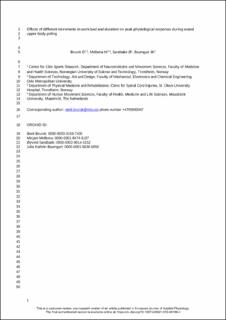| dc.contributor.author | Brurok, Berit | |
| dc.contributor.author | Mellema, Mirjam | |
| dc.contributor.author | Sandbakk, Øyvind | |
| dc.contributor.author | Baumgart, Julia Kathrin | |
| dc.date.accessioned | 2020-09-01T13:24:49Z | |
| dc.date.available | 2020-09-01T13:24:49Z | |
| dc.date.created | 2019-09-05T15:27:22Z | |
| dc.date.issued | 2019 | |
| dc.identifier.citation | European Journal of Applied Physiology. 2019, 119 (9), 2025-2031. | en_US |
| dc.identifier.issn | 1439-6319 | |
| dc.identifier.uri | https://hdl.handle.net/11250/2675882 | |
| dc.description.abstract | Purpose
To compare the effects of test protocols with different increments in workload and duration on peak oxygen uptake (V˙O2peak), and related physiological parameters during seated upper-body poling (UBP).
Methods
Thirteen upper-body trained, male individuals completed four UBP test protocols with increments in workload until volitional exhaustion in a counterbalanced order: 20 W increase/every 30 s, 20 W/60 s, 10 W/30 s and 10 W/60 s. Cardio-respiratory parameters and power output were measured throughout the duration of each test. Peak blood lactate concentration (bLapeak) was measured after each test.
Results
The mixed model analysis revealed no overall effect of test protocol on V˙O2peak, peak minute ventilation (VEpeak), peak heart rate (HRpeak), bLapeak (all p ≥ 0.350), whereas an overall effect of test protocol was found on peak power output (POpeak) (p = 0.0001), respiratory exchange ratio (RER) (p = 0.024) and test duration (p < 0.001). There was no difference in POpeak between the 20 W/60 s (175 ± 25 W) and 10 W/30 s test (169 ± 27 W; p = 0.092), whereas POpeak was lower in the 10 W/60 s test (152 ± 21 W) and higher in the 20 W/30 s test (189 ± 30 W) compared to the other tests (all p = 0.001). In addition, RER was 9.9% higher in the 20 W/30 s compared to the 10 W/60 s test protocol (p = 0.003).
Conclusions
The UBP test protocols with different increments in workload and duration did not influence V˙
O2peak, and can therefore be used interchangeably when V˙O2peak is the primary outcome. However, POpeak and RER depend upon the test protocol applied and the UBP test protocols can, therefore, not be used interchangeably when the latter is the primary outcome parameter. | en_US |
| dc.language.iso | eng | en_US |
| dc.publisher | Springer Verlag | en_US |
| dc.title | Effects of different increments in workload and duration on peak physiological responses during seated upper-body poling | en_US |
| dc.type | Peer reviewed | en_US |
| dc.type | Journal article | en_US |
| dc.description.version | acceptedVersion | en_US |
| dc.source.pagenumber | 2025-2031 | en_US |
| dc.source.volume | 119 | en_US |
| dc.source.journal | European Journal of Applied Physiology | en_US |
| dc.source.issue | 9 | en_US |
| dc.identifier.doi | 10.1007/s00421-019-04189-4 | |
| dc.identifier.cristin | 1721987 | |
| dc.description.localcode | This is a post-peer-review, pre-copyedit version of an article. | en_US |
| cristin.unitcode | 1920,5,0,0 | |
| cristin.unitcode | 194,65,30,0 | |
| cristin.unitname | Klinikk for fysikalsk medisin og rehabilitering | |
| cristin.unitname | Institutt for nevromedisin og bevegelsesvitenskap | |
| cristin.ispublished | true | |
| cristin.fulltext | original | |
| cristin.qualitycode | 1 | |
